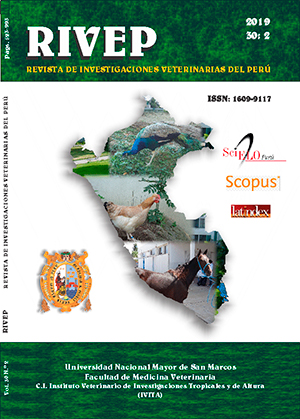Effect of five levels of tara gum on the productive performance, bone mineralization and intestinal morphology in broilers
DOI:
https://doi.org/10.15381/rivep.v30i2.16100Keywords:
tara gum; prebiotic; broilers; bone morphometry; gutAbstract
The aim of this study was to determine the effect of five levels of tara gum on productive performance, bone mineralization, glucose and cholesterol levels, and intestinal morphometry in broilers from 1 to 21 days of age. A total of 200 male BB cobs of the Cobb500 line were used, distributed in five treatments with four repetitions and 10 animals per repetition: T1, basal diet without tara gum (control); T2, T3, T4 and T5, basal diet with tara gum (0.05, 0.10, 0.15 and 0.20% respectively). All diets contained 3072 kcal ME/kg and 20.5% crude protein. The feed meal and water were offered ad libitum. The data were analyzed under a completely randomized design using the ANOVA procedure and the Duncan test for comparison of means. The results showed that body weight and body-weight gain were better in T3 than in T4 and T5 (p<0.05), both in the second and in the third week of age. Also, tara gum influenced the depth of the crypt and the height of the villus and crypt in the jejunum compared to the control group. No statistical difference was found in indicators of bone mineralization, cholesterol or glucose levels. It is concluded that the addition of 0.1% tara gum favors body weight, body-weight gain and intestinal morphology in broilers.
Downloads
Downloads
Published
Issue
Section
License
Copyright (c) 2019 Otto Zea M., Daniel Huaringa E., Liliana Jiménez H., Jorge Pérez C., Josselyn Serrano G., Ivan Meza Q., Nathaly Bernuy O., Carlos Vílchez P.

This work is licensed under a Creative Commons Attribution-NonCommercial-ShareAlike 4.0 International License.
AUTHORS RETAIN THEIR RIGHTS:
a. Authors retain their trade mark rights and patent, and also on any process or procedure described in the article.
b. Authors retain their right to share, copy, distribute, perform and publicly communicate their article (eg, to place their article in an institutional repository or publish it in a book), with an acknowledgment of its initial publication in the Revista de Investigaciones Veterinarias del Perú (RIVEP).
c. Authors retain theirs right to make a subsequent publication of their work, to use the article or any part thereof (eg a compilation of his papers, lecture notes, thesis, or a book), always indicating the source of publication (the originator of the work, journal, volume, number and date).










